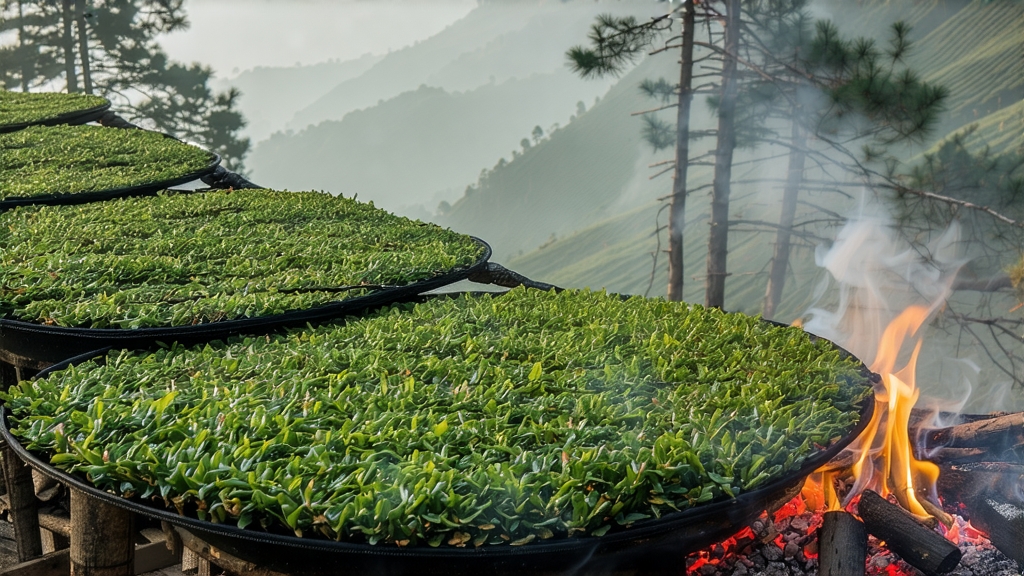
When European tea clippers first rounded the Cape of Good Hope in the late seventeenth century, the chests that fetched the highest prices at London and Amsterdam auctions bore a mysterious inscription: “Bohea Souchong.” Inside were slender, pitch-black leaves that released a perfume unlike anything the West had tasted—campfire, resin, and a dark honey sweetness that clung to the tongue for hours. That tea was Lapsang Souchong, the earliest black tea ever created and the prototype for every subsequent red-black tea in China and beyond. Today, despite a crowded marketplace of golden buds and malty Yunnan golds, Lapsang remains the most polarizing and storied leaf in the Chinese pantheon—either adored as liquid bacon for the soul or dismissed as a tarry curiosity. To understand it is to glimpse the moment when Chinese green-tea culture pivoted toward the oxidized frontier that would conquer the world.
Origin and terroir
The tea hails from Tongmu Guan, a protected enclave tucked high in the Wuyi Mountains of northern Fujian. Here, a microclimate of year-round mist, mineral-rich lateritic soil, and dramatic day-night temperature swings forces the xiao zhong (“small leaf” cultivar, hence “Souchong”) tea bushes to grow slowly, concentrating aromatic oils in the leaves. At 1,200–1,500 m elevation, the forest is still dominated by Masson pines and cedar; their resin saturates the air and, in the traditional process, becomes the tea’s signature flavor vector. Since 2002 Tongmu has been a Chinese national preservation zone: only a handful of registered families may produce authentic Zheng Shan (“Original Mountain”) Lapsang, and every kilo is tracked with a government seal.
From green to black—an accident that became a craft
Local legend says the style was born in 1646 when Qing army units quartered themselves in tea workshops during the transition from Ming loyalist resistance to Manchu rule. To dry the leaf quickly before the soldiers requisitioned the racks, workers spread it over pine fires. The resulting dark, smoky tea found unexpected favor with the Dutch, who were already smoking herring and thus welcomed a similarly assertive cup. Whether apocryphal or not, the story captures the key technological leap: the intentional use of complete oxidation followed by heat dehydration, a sequence that defines black tea to this day.
Two families, not one
Modern connoisseurs distinguish between two Lapsang lineages that share geography but diverge in process and philosophy.
-
Traditional Pine-Smoked Lapsang (Zheng Shan Xiao Zhong)
Harvest: one bud and two leaves picked in late April, after the Wuyi spring equinox rains.
Withering: 8–10 h on bamboo racks inside smoke-free upper lofts where mountain breezes reduce moisture to 60 %.
Rolling: light rotary pressure for 45 min to rupture cells without stripping fuzz; the leaf remains strip-shaped.
Oxidation: 3–4 h in wooden troughs lined with wet cloth; the pile is turned every 30 min to ensure even reddening.
Smoking & Drying: the critical stage. Fresh pinewood is burned in a pit below the firing room; the smoke is ducted sideways so only cool, aromatic air contacts the tea. Workers shuffle the leaves every 20 min for eight hours, allowing phenols and guaiacol to bond with the leaf sugars. Final moisture is 4–5 %.
Rest: the tea is sealed in clay jars for 30 days so smoke softens and integrates. -
Unsmoked “Fruit Style” Lapsang (Wu Xun Xiao Zhong)
Developed in 2005 for the delicate East-Asian palate, this version omits pine smoke. Instead, the leaf is withered over charcoal embers made from local hardwood, then baked at 80 °C in cast-iron pans. The cup is biscuity, with longan and dried apricot notes, proving that Tongmu terroir alone can stand without its campfire cloak.
Chemical signature
Gas-chromatography studies show that traditional Lapsang carries 3–5 times more guaiacol, 4-methyl-guaiacol, and eugenol than any other black tea, compounds responsible for smoked meat and clove aromas. Yet it also contains unusually high levels of gerani